
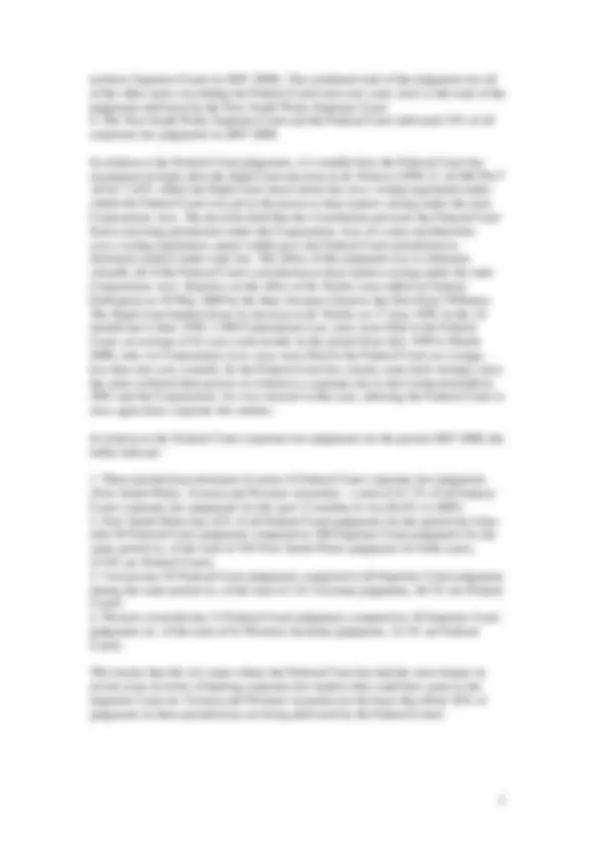
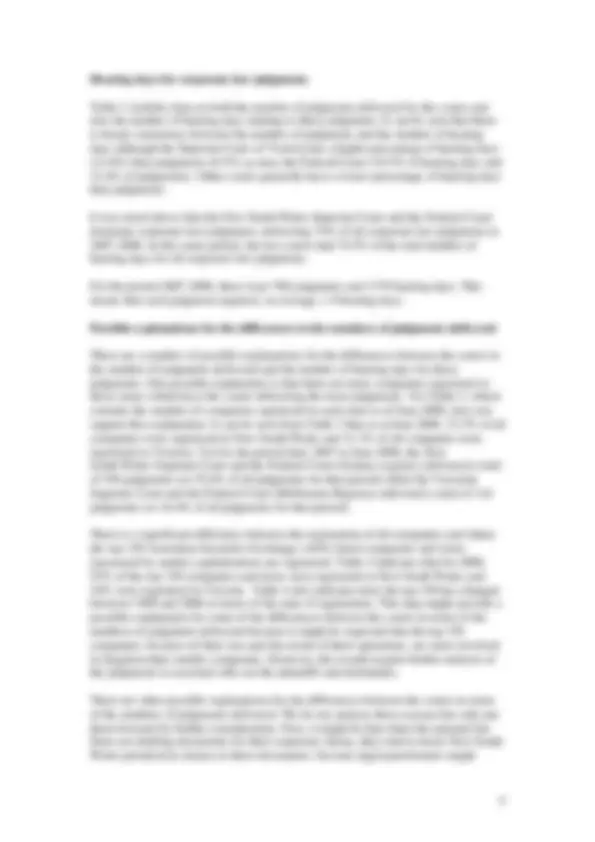
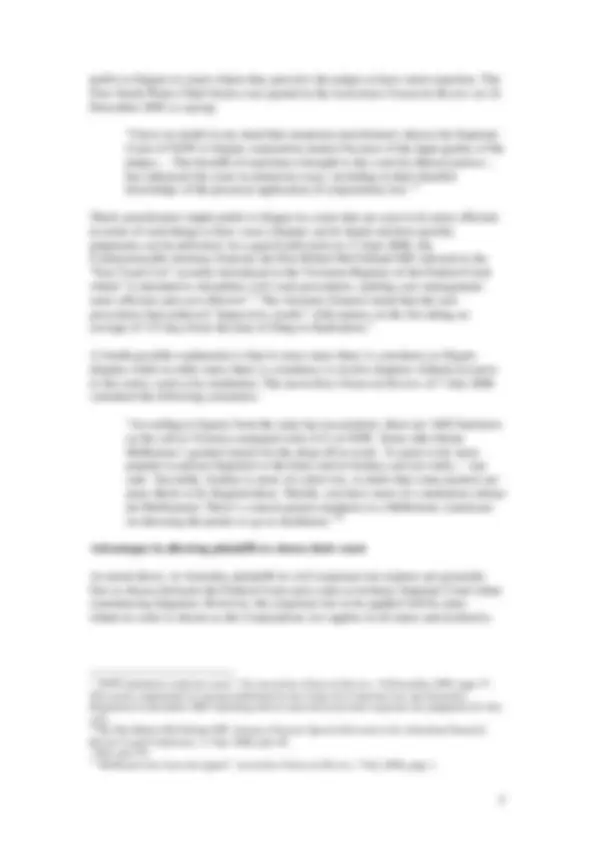
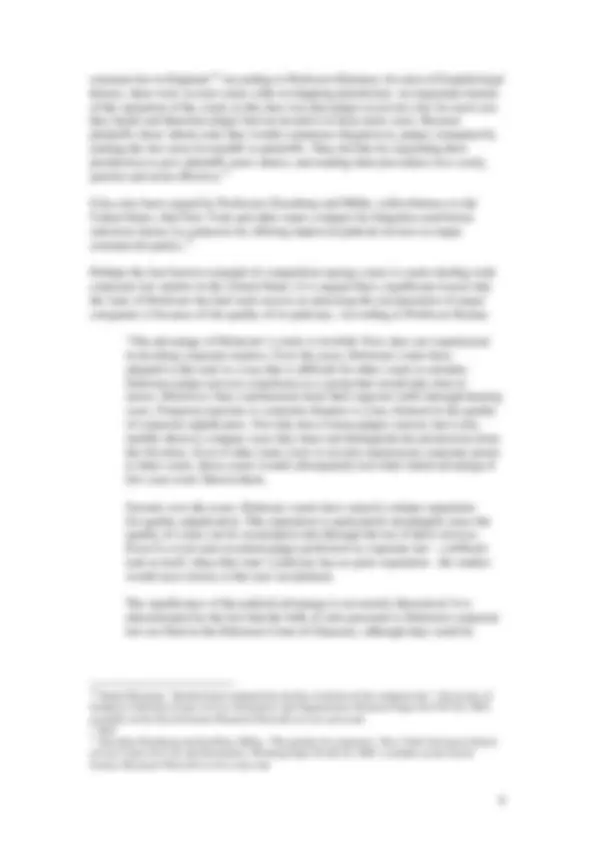
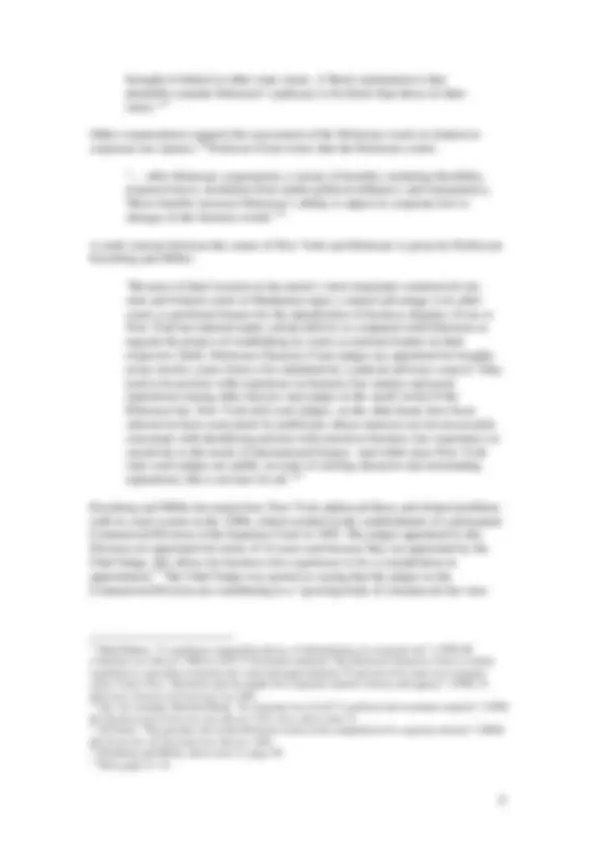
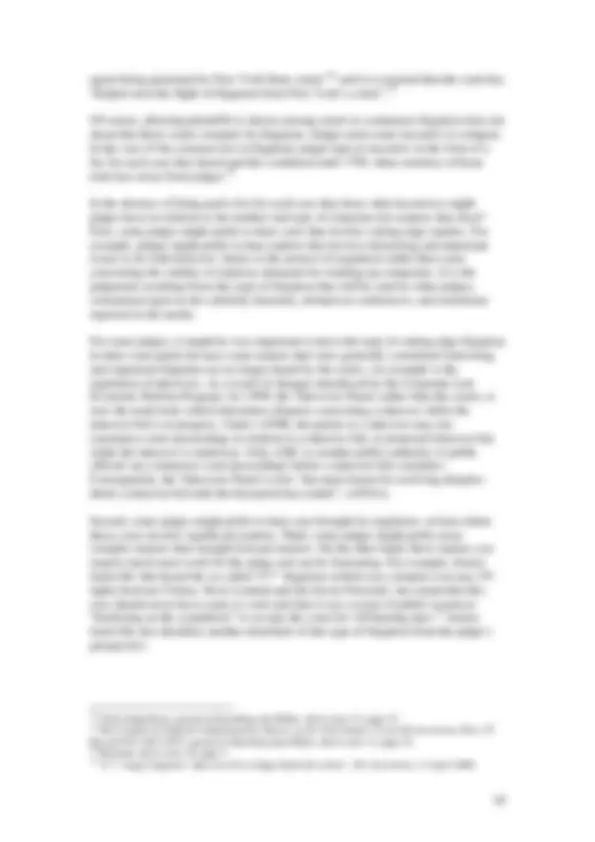
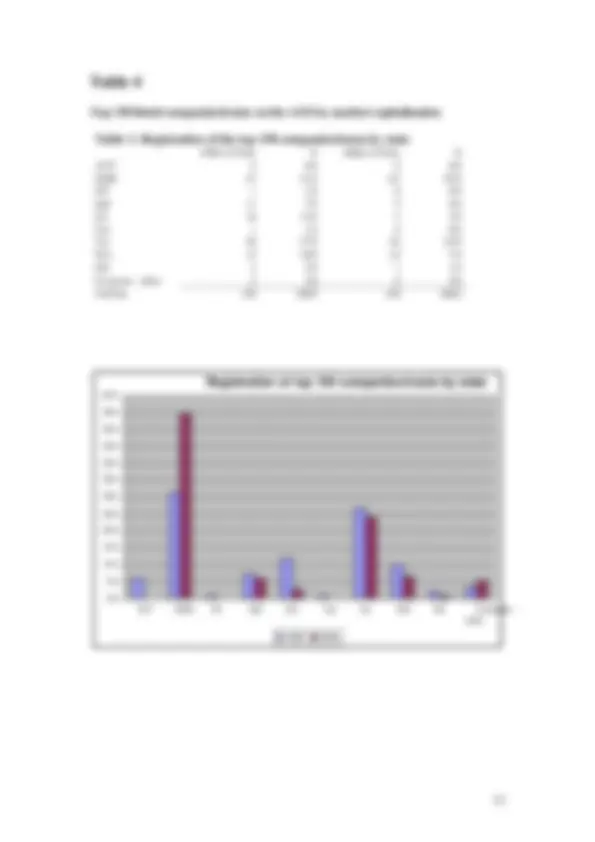
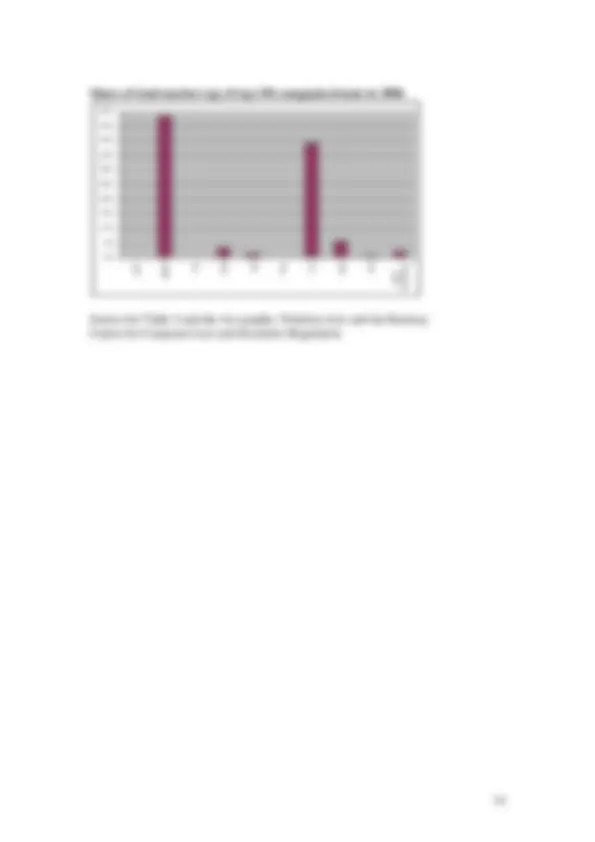


Study with the several resources on Docsity

Earn points by helping other students or get them with a premium plan


Prepare for your exams
Study with the several resources on Docsity

Earn points to download
Earn points by helping other students or get them with a premium plan
Community
Ask the community for help and clear up your study doubts
Discover the best universities in your country according to Docsity users
Free resources
Download our free guides on studying techniques, anxiety management strategies, and thesis advice from Docsity tutors
An overview of the jurisdiction of Australian courts in corporate law matters, focusing on the Federal Court and its comparison with state and territory Supreme Courts. The research findings highlight the dominance of certain jurisdictions in terms of corporate law judgments and the advantages of allowing plaintiffs to choose their court.
Typology: Slides
1 / 14

This page cannot be seen from the preview
Don't miss anything!









Introduction
This research note outlines the results of research undertaken by the authors indicating which courts deliver most corporate law judgments. The authors examined which courts delivered corporate law judgment for two periods: June 2007 to June 2008 (see Table 1) and December 2004 to December 2005 (see Table 2). The courts examined were the state Supreme Courts, the Federal Court of Australia and the High Court of Australia. Statistics for the Administrative Appeals Tribunal are also presented.^1
The source for the research is the corporate law judgments website of the Centre for Corporate Law and Securities Regulation at the University of Melbourne which is at:
http://cclsr.law.unimelb.edu.au/
The structure of the research note is as follows. In the first section we provide a brief overview of the jurisdiction of Australian courts in corporate law matters. This is followed by discussion of the research findings relating to which courts deliver most corporate law judgments and the number of hearing days relating to those judgments. Possible explanations for the differences in the numbers of judgments delivered are then explored. The research note then discusses the advantages in allowing plaintiffs to choose their court. The note concludes with discussion of whether courts compete for corporate law litigation and the possible incentive for judges to compete for such litigation.
The jurisdiction of Australian courts in corporate law matters
The jurisdiction of courts to deal with matters arising under the Corporations Act is determined by Part 9.6A of the Act. In relation to civil matters, s 1337B provides that jurisdiction is conferred on the Federal Court of Australia and also on the Supreme Courts of the states and territories with respect to civil matters arising under the Corporations Act. Jurisdiction is also conferred on the Family Court and the lower courts of the states and territories in relation to civil matters other than superior court matters: ss 1337C and 1337E.
The effect of these provisions is that plaintiffs in civil corporate law matters are generally free to choose between the Federal Court and a state or territory Supreme
(^1) The Administrative Appeals Tribunal is not a court. However, because it does deal with some
corporate law matters, data on the number of decisions it delivers is included in the tables.
Court when commencing litigation. This freedom will be restricted where the parties to a dispute have previously chosen a particular jurisdiction to settle disputes (for example, the parties have selected a particular state court to have any disputes litigated through a choice of forum clause in a governing document).
Part 9.6A of the Corporations Act also provides for the transfer of proceedings with respect to civil matters. In brief, where a proceeding is commenced in the Federal Court or the Supreme Court of a state or territory, this court may transfer the proceeding to another court that has jurisdiction if it appears to the court that, having regard to the interests of justice, it is more appropriate for the proceeding to be transferred to that court. There are similar provisions allowing transfers that apply to the Family Court and the lower courts of the states and territories.
A court may transfer a proceeding on the application of a party at any stage of the proceeding or of the court's own motion: s 1337M.
In deciding whether to transfer a proceeding, a court must have regard to:
In relation to criminal matters, jurisdiction is conferred on the courts of criminal jurisdiction of the states and territories to deal with offences under the Corporations Act: Part 9.6B Division 2 of the Corporations Act. The Federal Court has no criminal jurisdiction to deal with contraventions of the Corporations Act but it can impose civil penalties in proceedings over which it has jurisdiction as these are treated in the Corporations Act as part of the civil law.^2
Comparison of courts’ activity in delivering corporate law judgments
The research findings are contained in Tables 1 and 2. The following points can be made in relation to the research:
(^2) HAJ Ford, RP Austin and IM Ramsay, Ford's Principles of Corporations Law, looseleaf edition
[3.330].
Hearing days for corporate law judgments
Table 1 includes data on both the number of judgments delivered by the courts and also the number of hearing days relating to these judgments. It can be seen that there is broad consistency between the number of judgments and the number of hearing days although the Supreme Court of Victoria has a higher percentage of hearing days (12.8%) than judgments (8.5%) as does the Federal Court (34.5% of hearing days and 31.6% of judgments). Other courts generally have a lower percentage of hearing days than judgments.
It was noted above that the New South Wales Supreme Court and the Federal Court dominate corporate law judgments, delivering 74% of all corporate law judgments in 2007-2008. In this same period, the two courts had 74.5% of the total number of hearing days for all corporate law judgments.
For the period 2007-2008, there were 708 judgments and 1378 hearing days. This means that each judgment required, on average, 1.9 hearing days.
Possible explanations for the differences in the numbers of judgments delivered
There are a number of possible explanations for the differences between the courts in the number of judgments delivered and the number of hearing days for those judgments. One possible explanation is that there are more companies registered in those states which have the courts delivering the most judgments. Yet Table 3, which contains the number of companies registered in each state as of June 2008, does not support this explanation. It can be seen from Table 3 that as at June 2008, 33.3% of all companies were registered in New South Wales and 31.3% of all companies were registered in Victoria. Yet for the period June 2007 to June 2008, the New South Wales Supreme Court and the Federal Court (Sydney registry) delivered a total of 394 judgments (or 55.6% of all judgments for that period) while the Victorian Supreme Court and the Federal Court (Melbourne Registry) delivered a total of 116 judgments (or 16.4% of all judgments for that period).
There is a significant difference between the registration of all companies and where the top 150 Australian Securities Exchange (ASX) listed companies and trusts (measured by market capitalisation) are registered. Table 4 indicates that for 2006, 55% of the top 150 companies and trusts were registered in New South Wales and 24% were registered in Victoria. Table 4 also indicates how the top 150 has changed between 1990 and 2006 in terms of the state of registration. This data might provide a possible explanation for some of the differences between the courts in terms of the numbers of judgments delivered because it might be expected that the top 150 companies, because of their size and the extent of their operations, are more involved in litigation than smaller companies. However, this would require further analysis of the judgments to ascertain who are the plaintiffs and defendants.
There are other possible explanations for the differences between the courts in terms of the numbers of judgments delivered. We do not analyse these reasons but only put them forward for further consideration. First, it might be that when the national law firms are drafting documents for their corporate clients, they tend to insert New South Wales jurisdiction clauses in these documents. Second, legal practitioners might
prefer to litigate in courts where they perceive the judges to have more expertise. The New South Wales Chief Justice was quoted in the Australian Financial Review on 16 December 2005 as saying:
“I have no doubt in my mind that numerous practitioners choose the Supreme Court of NSW to litigate corporation matters because of the high quality of the judges… The breadth of experience brought to the court by [these] justices… has enhanced the court in numerous ways, including in their detailed knowledge of the practical application of corporations law.”^3
Third, practitioners might prefer to litigate in courts that are seen to be more efficient in terms of such things as how soon a dispute can be heard and how quickly judgments can be delivered. In a speech delivered on 17 June 2008, the Commonwealth Attorney General, the Hon Robert McClelland MP, referred to the “Fast Track List” recently introduced in the Victorian Registry of the Federal Court which “is intended to streamline civil court procedures, making case management more efficient and cost effective”.^4 The Attorney General stated that the new procedures had achieved “impressive results” with matters on the list taking an average of 115 days from the date of filing to finalisation.^5
A fourth possible explanation is that in some states there is a tendency to litigate disputes while in other states there is a tendency to resolve disputes without recourse to the courts, such as by mediation. The Australian Financial Review of 7 July 2006 contained the following comments:
“According to figures from the state bar associations, there are 1602 barristers on the roll in Victoria compared with 2121 in NSW. Some silks blame Melbourne’s genteel nature for the drop-off in work. ‘It seems to be more popular to pursue litigation to the bitter end in Sydney and not settle...’ one said. ‘Secondly, Sydney is more of a deal city, so deals that come unstuck are more likely to be litigated there. Thirdly, you have more of a mediation culture [in Melbourne]. There’s a much greater emphasis in a Melbourne courtroom on directing the parties to go to mediation.’”^6
Advantages in allowing plaintiffs to choose their court
As noted above, in Australia, plaintiffs in civil corporate law matters are generally free to choose between the Federal Court and a state or territory Supreme Court when commencing litigation. However, the corporate law to be applied will be same whatever court is chosen as the Corporations Act applies in all states and territories.
(^3) “NSW dominates corporate cases”, The Australian Financial Review, 16 December 2005, page 47.
This article commented on research published by the Centre for Corporate Law and Securities Regulation in December 2005 indicating which courts delivered most corporate law judgments for that year. (^4) The Hon Robert McClelland MP, Attorney-General, Speech delivered to the Australian Financial
Review Legal Conference, 17 June 2008, para 48. (^5) Ibid, para 49. (^6) “Melbourne bar loses star appeal”, Australian Financial Review, 7 July 2006, page 1.
Some hint of competition between the New South Wales Supreme Court and the other court might be seen in the comments of the Chief Justice of the New South Wales Supreme Court, quoted above, that numerous practitioners choose the Supreme Court of New South Wales to litigate corporate matters because of the high quality of the judges. There might also be a hint of competition in a column in the Australian Financial Review written by two judges of the New South Wales Supreme Court and published on 26 July 1999 following the decision of the High Court in Re Wakim. As noted above, the result of this decision was that the Federal Court lost its jurisdiction to hear corporate law matters until this was restored in 2001 when the states referred their powers in relation to corporate law to the Commonwealth. Where would corporate law litigation that plaintiffs might have otherwise commenced in the Federal Court go? The two judges wrote:
“Anticipating Wakim, a substantial majority of the Corporations Law cases in NSW have come to be litigated in the Supreme Court of NSW rather than the Federal Court. As a result of the High Court decision and subsequent legislation, the Federal Court has given an estimate indicating that only about 50 matters are involved. Many of them are routine winding-up matters which are handled by the Registrar. On the basis of this estimate, the volume of work is well within the resources of this court.
There is no lack of expertise in the Equity Division of this court to deal with complex corporate matters. The Federal Courts (State Jurisdiction) Act and new court rules to support it are now operative. The NSW Supreme Court is already handling Federal Court cases under the new arrangements with no difficulty.
Corporations Law cases are allocated to the specialist Corporations List administered by ourselves. This list allows proceedings to be case-managed to prepare them for hearing. Short matters are heard and determined in the list when they are ready. There is no backlog. Longer matters are given expedition as they require. Appeals are also expedited where appropriate.
A Corporations Law Users Group has been established in NSW as a forum between judges, ASIC and other users to enhance and maintain the efficiency of the arrangements for dealing with Corporations Law matters in this court.”^8
The two judges concluded by stating:
“Media reporting after the decision in Wakim has suggested that the country's corporate community and courts have been caught unawares and uncertainty will reign. Far from it, NSW has already accommodated the new work, and other States will follow.”^9
The suggestion that courts compete for litigation is not new. It has been argued that competition between courts played an important role in the development of the
(^8) GFK Santow and R Austin, “No doubts in Wakim wake”, The Australian Financial Review, 26 July
1999, page 20. (^9) Ibid.
common law in England. 10 According to Professor Klerman, for most of English legal history, there were several courts with overlapping jurisdiction. An important feature of the operation of the courts at this time was that judges received a fee for each case they heard and therefore judges had an incentive to hear more cases. Because plaintiffs chose which court they would commence litigation in, judges competed by making the law more favourable to plaintiffs. They did this by expanding their jurisdiction to give plaintiffs more choice, and making their procedures less costly, quicker and more effective.^11
It has also been argued by Professors Eisenberg and Miller, with reference to the United States, that New York and other states compete for litigation (and forum selection clauses in contracts) by offering improved judicial services to major commercial parties.^12
Perhaps the best known example of competition among courts is courts dealing with corporate law matters in the United States. It is argued that a significant reason why the state of Delaware has had such success in attracting the incorporation of major companies is because of the quality of its judiciary. According to Professor Kamar:
“The advantage of Delaware’s courts is twofold. First, they are experienced in deciding corporate matters. Over the years, Delaware courts have adapted to this task in a way that is difficult for other courts to emulate. Delaware judges possess experience as a group that would take time to amass. Moreover, they continuously hone their superior skills through hearing cases. Frequent exposure to corporate disputes is a key element in the quality of corporate adjudicators. Not only does it keep judges current, but it also enables them to compare cases they hear and distinguish the meritorious from the frivolous. Even if other states were to recruit experienced corporate jurists to their courts, those courts would subsequently lose their initial advantage if few cases were filed in them.
Second, over the years, Delaware courts have earned a unique reputation for quality adjudication. This reputation is particularly meaningful since the quality of courts can be ascertained only through the use of their services. Even if a rival state recruited judges proficient in corporate law - a difficult task in itself, when that state’s judiciary has no prior reputation - the market would react slowly to this new recruitment.
The significance of the judicial advantage is not merely theoretical. It is demonstrated by the fact that the bulk of suits pursuant to Delaware corporate law are filed in the Delaware Court of Chancery, although they could be
(^10) Daniel Klerman, “Jurisdictional competition and the evolution of the common law”, University of
Southern California Center in Law, Economics and Organization, Research Paper No C07-04, 2007, available on the Social Science Research Network at www.ssrn.com (^11) Ibid. (^12) Theodore Eisenberg and Geoffrey Miller, “The market for contracts”, New York University School
of Law Center for Law and Economics, Working Paper No 06-45, 2007, available on the Social Science Research Network at www.ssrn.com
again being generated by New York State courts”^18 and it is asserted that the court has “helped stem the flight of litigation from New York’s courts”. 19
Of course, allowing plaintiffs to choose among courts to commence litigation does not mean that these courts compete for litigation. Judges need some incentive to compete. In the case of the common law in England, judges had an incentive in the form of a fee for each case they heard and this continued until 1799, when statutory reforms took fees away from judges.^20
In the absence of being paid a fee for each case they hear, what incentives might judges have in relation to the number and type of corporate law matters they hear? First, some judges might prefer to hear cases that involve cutting edge matters. For example, judges might prefer to hear matters that involve interesting and important issues to do with directors’ duties or the powers of regulators rather than cases concerning the validity of statutory demands for winding up companies. It is the judgments resulting from this type of litigation that will be read by other judges, commented upon in the scholarly literature, debated at conferences, and sometimes reported in the media.
For some judges, it might be very important to have this type of cutting edge litigation in their court partly because some matters that were generally considered interesting and important litigation are no longer heard by the courts. An example is the regulation of takeovers. As a result of changes introduced by the Corporate Law Economic Reform Program Act 1999, the Takeovers Panel, rather than the courts, is now the main body which determines disputes concerning a takeover while the takeover bid is in progress. Under s 659B, the parties to a takeover may not commence court proceedings in relation to a takeover bid, or proposed takeover bid, while the takeover is underway. Only ASIC or another public authority or public official can commence court proceedings before a takeover bid concludes. Consequently, the Takeovers Panel is now “the main forum for resolving disputes about a takeover bid until the bid period has ended”: s 659AA.
Second, some judges might prefer to hear case brought by regulators, at least where those cases involve significant matters. Third, some judges might prefer more complex matters than straight forward matters. On the other hand, these matters can require much more work for the judge and can be frustrating. For example, Justice Sackville who heard the so-called “C7” litigation (which was a dispute over pay-TV rights between Telstra, News Limited and the Seven Network) has stated that this case should never have come to court and that it was a waste of public resources “bordering on the scandalous” to occupy the court for 120 hearing days.^21 Justice Sackville also identifies another drawback of this type of litigation from the judge’s perspective:
(^18) Chief Judge Kaye, quoted in Eisenberg and Miller, above note 12, page 43. (^19) The Council on Judicial Administration, Report on the Chief Judge's Court Restructuring Plan , 52
Record 929, 948 (1997), quoted in Eisenberg and Miller, above note 12, page 43. (^20) Klerman, above note 10, page 3. (^21) “C-7 ‘mega-litigation’ takes its toll as Judge Sackville retires”, The Australian, 12 April 2008.
“You are not moving from subject to subject, you are not going to a new set of issues, a new set of challenges and you are not getting the feeling of completing something and moving on to the next thing.”^22
The C7 litigation was not a corporate law matter. However, there can be very complex corporate law matters involving many hearing days that would raise the issue mentioned by Justice Sackville. However, as noted above, for the period June 2007 – June 2008, each corporate law judgment required, on average, only 1.9 hearing days.
Fourth, some judges might prefer to maximise the total number of corporate law matters in their state or federal court as this will allow them more choice over the specific corporate law matters they hear. Fifth, some judges might prefer to work in a court that has a strong flow of corporate law matters if they believe that corporate law litigation is more prestigious than some other types of litigation.
Conclusion
This research note has documented which courts deliver most corporate law judgments. The New South Wales Supreme Court and the Federal Court dominate corporate law judgments, delivering 74% of all corporate law judgments in 2007-2008. In this same period, these two courts had 74.5% of the total number of hearing days for all corporate law judgments. The two states where the Federal Court has had the most impact in recent years in terms of hearing corporate law matters that could have gone to the Supreme Court are Victoria and Western Australia (on the basis that about 50% of judgments in these jurisdictions are being delivered by the Federal Court).
In relation to hearing days, for the period 2007-2008, there were 708 judgments and 1378 hearing days. This means that each judgment required, on average, 1.9 hearing days.
Possible explanations for the differences in the numbers of judgments delivered were explored. In addition, because in Australia plaintiffs in civil corporate law matters are generally free to choose between the Federal Court and a state or territory Supreme Court when commencing litigation, the advantages of allowing plaintiffs to do this were discussed. The note concluded with discussion of whether courts compete for corporate law litigation and what might be the incentives to compete.
(^22) Ibid.
Top 150 listed companies/trusts on the ASX by market capitalisation
Table 1: Registration of the top 150 companies/trusts by state 1990 (23 Feb) % 2006 (23 Feb) % ACT 9 6% 0 0% NSW 47 31% 82 55% NT 1 1% 0 0% Qld 11 7% 9 6% SA 18 12% 4 3% Tas 1 1% 0 0% Vic 40 27% 36 24% WA 15 10% 10 7% NZ 3 2% 1 1% Overseas - other 5 3% 8 5% TOTAL 150 100% 150 100%
Registration of top 150 companies/trusts by state
0%
5%
10%
15%
20%
25%
30%
35%
40%
45%
50%
55%
60%
ACT NSW NT Qld SA Tas Vic WA NZ Overseas - other 1990 2006
Share of total market cap of top 150 companies/trusts in 2006
0%
5%
10%
15%
20%
25%
30%
35%
40%
45%
50%
ACT NSW NT Qld SA Tas Vic WA NZ Overseas - other
Source for Table 4 and the two graphs: Nicholas Lew and Ian Ramsay, Centre for Corporate Law and Securities Regulation